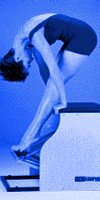|
Thai massage is the lazy woman's
yoga - all the benefits, none of the work. You lie passively while
an energetic masseur pulls and manipulates your body into numerous
stretches. Even better, it is the latest fad to fire the imagination
of celebrities and yoga devotees alike.
Sting and Kevin Bacon are the most
recent converts to Thai massage. It's also a popular craze among
American fitness cognoscenti who, instead of suffering the indignity
of getting sweaty in the gym, are heading for the Institute of Thai
Massage near West Palm Beach, Florida. London's Life Centre in Notting
Hill, where Mariella Frostrup goes to limber up, also reports a
surge of enthusiasm for the new effort-free yoga, and the Kailash
Centre of Oriental Medicine in St John's Wood is taking more bookings
than ever. "It's the ideal form of yoga," says Howard Evans, a Thai
massage practitioner who teaches the technique at the University
of Westminster. "Many yoga classes are dynamic, so are designed
to give you a workout. But one of the main ideas of yoga, is that
you should relax into it. Thai massage allows just that."
The technique evolved as part of
an ancient medicinal tradition that emerged in India more than 2,000
years ago, where it grew up alongside yoga and Ayurvedic medicine.
It spread to Thailand with Buddhism and is used with herbs and spiritual
practice to enhance wellbeing and heal illness.
"Yoga and Thai massage come from
similar traditions, so many of the moves are very similar," explains
Evans. "Rather than kneading muscles as in Swedish massage, you
manipulate the limbs and joints, stretching them gently. That makes
the muscles- not only near the skin's surface, but deep within the
body - relax. You also press on key pressure points on the feet,
spine,Uarms and hands."
Practitioners work along the body's
10 main energy or "sen" lines, which correspond to the "nadis" of
yoga and the "meridians" of Chinese medicine, and nearly always
begin a Ethe feet. "The feet are filled with nerves that correspond
to different points in the body, so stimulating them will relax
you everywhere," says Evans. "Then you work up the legs, to the
stomach, back and arms. You end at the head and neck, having gradually
relaxed everything."
The energy lines, he explains, correspond
to the lymphatic system and work on the body's connective tissue.
Stimulating these lines releases toxins, boosts blood circulation
and frees up muscular tension.
Ultimately, the aim is to restore
any energy imbalances in the body. "The overall effect is immense:
a good Thai massage can cure headaches and fatigue, ease insomnia
and alleviate digestive problems, anxiety and depression," says
Evans.
Mos Ipeople, however, have it simple
to relax. Nicole Henry, a 29- year- old PR executive, embarked on
a nine-day course in Thai massage late last year. "I'd go for a
90-minute massage feeling tired and run down after a late night
and a hectic day at work," she says. "I'd come out feeling incredibly
energised. It totally transformed my mood, taking away any negativity
or tension.
"Also, I found it much more dignified
than the semi-naked oily Swedish massage," she adds. You stay fully
clothed for Thai massage, although the clothes you wear should be
light and loose.
"Now I practise on friends; it turns
them into blobs of jelly. It is almost as effective healthwise for
the person giving it as for the one receiving - you have to climb
all over the person, stretching them around, which is a workout
in itself."
For information on practitioners
nationwide, courses and massage, contact Howard Evans (tel: 020U7727
8526). Massage students offer Thai massage at the University of
Westminster Polyclinic (£15 for a 90-minute session; tel:
020 7911 5041). Thai massage is also available at the Kailash Centre
of Oriental Medicine,
7 Newcourt Street, London
NW8 (£65 for 90 minutes; tel: 020 7722 3939).
The Institute of Thai Massage website
is at www.thai- massage.org/
|



